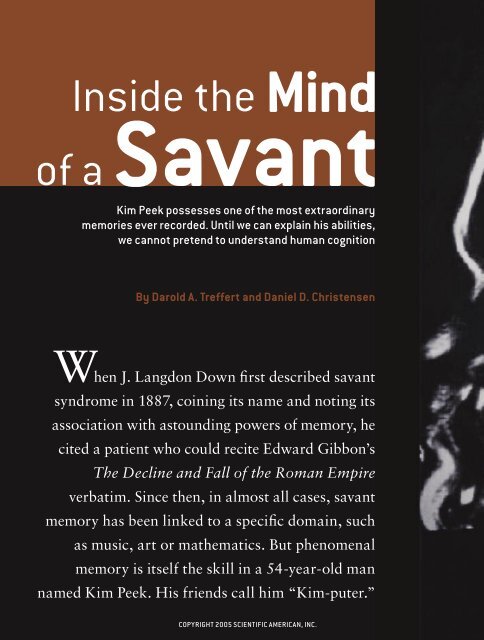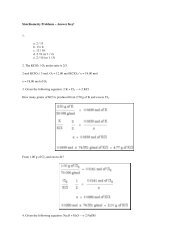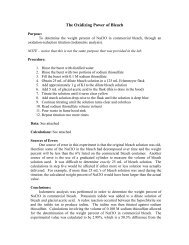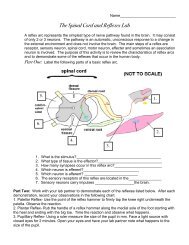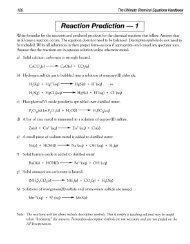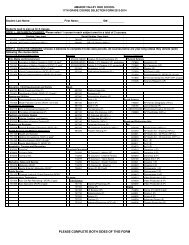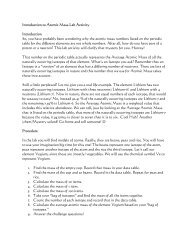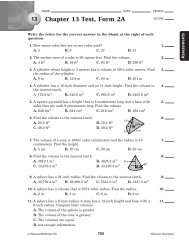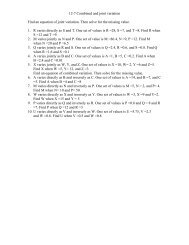Inside the Mind of a Savant
Inside the Mind of a Savant
Inside the Mind of a Savant
You also want an ePaper? Increase the reach of your titles
YUMPU automatically turns print PDFs into web optimized ePapers that Google loves.
<strong>Inside</strong> <strong>the</strong> <strong>Mind</strong><br />
<strong>of</strong> a <strong>Savant</strong><br />
Kim Peek possesses one <strong>of</strong> <strong>the</strong> most extraordinary<br />
memories ever recorded. Until we can explain his abilities,<br />
we cannot pretend to understand human cognition<br />
By Darold A. Treffert and Daniel D. Christensen<br />
When J. Langdon Down first described savant<br />
syndrome in 1887, coining its name and noting its<br />
association with astounding powers <strong>of</strong> memory, he<br />
cited a patient who could recite Edward Gibbon’s<br />
The Decline and Fall <strong>of</strong> <strong>the</strong> Roman Empire<br />
verbatim. Since <strong>the</strong>n, in almost all cases, savant<br />
memory has been linked to a specific domain, such<br />
as music, art or ma<strong>the</strong>matics. But phenomenal<br />
memory is itself <strong>the</strong> skill in a 54-year-old man<br />
named Kim Peek. His friends call him “Kim-puter.”<br />
C R E D I T<br />
108 S C I E N T I F I C A M E R I C A N D E C E M B E R 2 0 0 5<br />
COPYRIGHT 2005 SCIENTIFIC AMERICAN, INC.
C R E D I T<br />
KIM PEEK stands in front<br />
<strong>of</strong> an image <strong>of</strong> his brain.<br />
w w w. s c i a m . c o m S C I E N T I F I C A M E R I C A N 109<br />
COPYRIGHT 2005 SCIENTIFIC AMERICAN, INC.
He can, indeed, pull a fact from his mental library as fast<br />
as a search engine can mine <strong>the</strong> Internet. He read Tom Clancy’s<br />
The Hunt for Red October in one hour and 25 minutes.<br />
Four months later, when asked, he gave <strong>the</strong> name <strong>of</strong> <strong>the</strong> Russian<br />
radio operator in <strong>the</strong> book, referring to <strong>the</strong> page describing<br />
<strong>the</strong> character and quoting several passages verbatim. Kim<br />
began memorizing books at <strong>the</strong> age <strong>of</strong> 18 months, as <strong>the</strong>y<br />
were read to him. He has learned 9,000 books by heart so far.<br />
He reads a page in eight to 10 seconds and places <strong>the</strong> memorized<br />
book upside down on <strong>the</strong> shelf to signify that it is now<br />
on his mental “hard drive.”<br />
Kim’s memory extends to at least 15 interests—among<br />
<strong>the</strong>m, world and American history, sports, movies, geography,<br />
space programs, actors and actresses, <strong>the</strong> Bible, church<br />
history, literature, Shakespeare and classical music. He knows<br />
all <strong>the</strong> area codes and zip codes in <strong>the</strong> U.S., toge<strong>the</strong>r with <strong>the</strong><br />
television stations serving those locales. He learns <strong>the</strong> maps<br />
in <strong>the</strong> front <strong>of</strong> phone books and can provide Yahoo-like travel<br />
directions within any major U.S. city or between any pair<br />
<strong>of</strong> <strong>the</strong>m. He can identify hundreds <strong>of</strong> classical compositions,<br />
tell when and where each was composed and first performed,<br />
give <strong>the</strong> name <strong>of</strong> <strong>the</strong> composer and many biographical details,<br />
and even discuss <strong>the</strong> formal and tonal components <strong>of</strong> <strong>the</strong> music.<br />
Most intriguing <strong>of</strong> all, he appears to be developing a new<br />
skill in middle life. Whereas before he could merely talk about<br />
music, for <strong>the</strong> past two years he has been learning to play it.<br />
It is an amazing feat in light <strong>of</strong> his severe developmental<br />
problems—characteristics shared, in varying extents, by all<br />
savants. He walks with a sidelong gait, cannot button his<br />
clo<strong>the</strong>s, cannot manage <strong>the</strong> chores <strong>of</strong> daily life and has great<br />
difficulties with abstraction. Against <strong>the</strong>se disabilities, his talents—which<br />
would be extraordinary in any person—shine all<br />
<strong>the</strong> brighter. An explanation <strong>of</strong> how Kim does what he does<br />
would provide better insight into why certain skills, including<br />
Overview/Peek’s Peaks<br />
■ Great powers <strong>of</strong> memory run through every known<br />
manifestation <strong>of</strong> savant skill. In <strong>the</strong> case <strong>of</strong> Kim Peek,<br />
memory is itself <strong>the</strong> skill.<br />
■ Kim’s brain exhibits many abnormalities, including an<br />
absent corpus callosum. The role <strong>of</strong> that particular<br />
abnormality in Kim’s case remains to be explained, but it<br />
evokes a question raised by <strong>the</strong> skills <strong>of</strong> all savants:<br />
Does brain damage stimulate compensatory<br />
development in some o<strong>the</strong>r area <strong>of</strong> <strong>the</strong> brain, or does it<br />
simply allow o<strong>the</strong>rwise latent abilities to emerge<br />
■ Kim’s rote learning later developed into a form <strong>of</strong><br />
associative thinking, with clear evidence <strong>of</strong> creativity.<br />
His success <strong>the</strong>n helped him engage <strong>the</strong> wider world.<br />
The authors conclude that savant skills should never be<br />
dismissed but should be cultivated for <strong>the</strong> patient’s<br />
intellectual and social development.<br />
<strong>the</strong> ordinarily obscure skill <strong>of</strong> calendar calculating (always<br />
associated with massive memory), occur with such regularity<br />
among savants. Recently, when an interviewer <strong>of</strong>fered that he<br />
had been born on March 31, 1956, Kim noted, in less than a<br />
second, that it was a Saturday on Easter weekend.<br />
Imaging studies <strong>of</strong> Kim’s brain thus far show considerable<br />
structural abnormality [see box on page 112]. These findings<br />
cannot yet be linked directly to any <strong>of</strong> his skills; that quest is<br />
just beginning. Newer imaging techniques that plot <strong>the</strong> brain’s<br />
functions—ra<strong>the</strong>r than just its structure—should provide more<br />
insight, though. In <strong>the</strong> meantime, we believe it is worthwhile<br />
to document <strong>the</strong> remarkable things that Kim can do. People<br />
like him are not easily found, and it is useful to record <strong>the</strong>ir<br />
characteristics for future research. <strong>Savant</strong>ism <strong>of</strong>fers a unique<br />
window into <strong>the</strong> mind. If we cannot explain it, we cannot<br />
claim full understanding <strong>of</strong> how <strong>the</strong> brain functions.<br />
An Unusual Brain<br />
k im was bor n on November 11, 1951 (a Sunday, he will<br />
tell you). He had an enlarged head, on <strong>the</strong> back <strong>of</strong> which was<br />
an encephalocele, or baseball-size “blister,” which spontaneously<br />
resolved. But <strong>the</strong>re were also o<strong>the</strong>r brain abnormalities,<br />
including a malformed cerebellum. One <strong>of</strong> us (Christensen)<br />
did <strong>the</strong> initial MRI brain scans on Kim in 1988 and has followed<br />
his progress ever since.<br />
The cerebellar findings may account for Kim’s problems<br />
with coordination and mobility. But more striking still is <strong>the</strong><br />
absence <strong>of</strong> a corpus callosum, <strong>the</strong> sizable stalk <strong>of</strong> nerve tissue<br />
that normally connects <strong>the</strong> left and right halves <strong>of</strong> <strong>the</strong> brain.<br />
We do not know what to make <strong>of</strong> this defect, because although<br />
it is rare, it is not always accompanied by functional<br />
disorders. Some people have been found to lack <strong>the</strong> structure<br />
without suffering any detectable problems at all. Yet in people<br />
whose corpus callosum has been severed in adulthood, generally<br />
in an effort to prevent epileptic seizures from spreading<br />
from one hemisphere to <strong>the</strong> o<strong>the</strong>r, a characteristic “splitbrain”<br />
syndrome arises in which <strong>the</strong> estranged hemispheres<br />
begin to work almost independently <strong>of</strong> each o<strong>the</strong>r.<br />
It would seem that those born without a corpus callosum<br />
somehow develop back channels <strong>of</strong> communication between<br />
<strong>the</strong> hemispheres. Perhaps <strong>the</strong> resulting structures allow <strong>the</strong><br />
two hemispheres to function, in certain respects, as one giant<br />
hemisphere, putting functions normally ra<strong>the</strong>r separate under<br />
<strong>the</strong> same ro<strong>of</strong>, as it were. If so, <strong>the</strong>n Kim may owe some <strong>of</strong> his<br />
talents to this particular abnormality. In any case, <strong>the</strong> fact<br />
that some people lacking a corpus callosum suffer no disabilities,<br />
whereas o<strong>the</strong>rs have savant abilities, makes its purpose<br />
less clear than formerly thought. Neurologists joke that<br />
its only two certain functions are to propagate seizures and<br />
hold <strong>the</strong> brain toge<strong>the</strong>r.<br />
Theory guides us in one respect. Kim’s brain shows abnormalities<br />
in <strong>the</strong> left hemisphere, a pattern found in many savants.<br />
What is more, left hemisphere damage has been invoked<br />
as an explanation <strong>of</strong> why males are much more likely<br />
E T H A N H I L L ( p r e c e d i n g p a g e s )<br />
110 S C I E N T I F I C A M E R I C A N D E C E M B E R 2 0 0 5<br />
COPYRIGHT 2005 SCIENTIFIC AMERICAN, INC.
E T H A N H I L L<br />
KIM RE ADS a page in eight to 10 seconds, learning it by heart as he<br />
goes. His mental library <strong>of</strong> 9,000 books includes encyclopedic<br />
coverage <strong>of</strong> everything from Shakespeare to musical composers to<br />
<strong>the</strong> maps <strong>of</strong> all major cities in <strong>the</strong> U.S.<br />
than females to display not only savantism but also dyslexia,<br />
stuttering, delayed speech, and autism. The proposed mechanism<br />
has two parts: male fetuses have a higher level <strong>of</strong> circulating<br />
testosterone, which can be toxic to developing brain<br />
tissue; and <strong>the</strong> left hemisphere develops more slowly than <strong>the</strong><br />
right and <strong>the</strong>refore remains vulnerable for a longer period.<br />
Also supporting <strong>the</strong> role <strong>of</strong> left hemisphere damage are <strong>the</strong><br />
many reported cases <strong>of</strong> “acquired savant syndrome,” in which<br />
older children and adults suddenly develop savant skills after<br />
damage to <strong>the</strong> left hemisphere.<br />
What does all this evidence imply One possibility is that<br />
when <strong>the</strong> left hemisphere cannot function properly, <strong>the</strong> right<br />
hemisphere compensates by developing new skills, perhaps by<br />
recruiting brain tissue normally earmarked for o<strong>the</strong>r purposes.<br />
Ano<strong>the</strong>r possibility is that injury to <strong>the</strong> left hemisphere<br />
merely unveils skills that had been latent in <strong>the</strong> right hemisphere<br />
all along, a phenomenon some have called a release<br />
from <strong>the</strong> “tyranny” <strong>of</strong> <strong>the</strong> dominant left hemisphere.<br />
Kim underwent psychological testing in 1988. His overall<br />
IQ score was 87, but <strong>the</strong> verbal and performance subtests<br />
varied greatly, with some scores falling in <strong>the</strong> superior range<br />
<strong>of</strong> intelligence and o<strong>the</strong>rs in <strong>the</strong> mentally retarded range. The<br />
psychological report concluded, <strong>the</strong>refore, that “Kim’s IQ<br />
classification is not a valid description <strong>of</strong> his intellectual ability.”<br />
The “general intelligence” versus “multiple intelligences”<br />
debate rages on in psychology. We believe that Kim’s case<br />
argues for <strong>the</strong> latter point <strong>of</strong> view.<br />
Kim’s overall diagnosis was “developmental disorder not<br />
o<strong>the</strong>rwise specified,” with no diagnosis <strong>of</strong> autistic disorder.<br />
Indeed, although autism is more commonly linked with savantism<br />
than is any o<strong>the</strong>r single disorder, only about half <strong>of</strong><br />
all savants are autistic. In contrast with autistic people, Kim<br />
is outgoing and quite personable. One thing that does seem<br />
necessary for <strong>the</strong> full development <strong>of</strong> savant skills is a strong<br />
interest in <strong>the</strong> subject matter in question.<br />
Memory and Music<br />
in k im’s case , all <strong>the</strong> interests began in rote memorization<br />
but later progressed to something more. Although Kim generally<br />
has a limited capacity for abstract or conceptual thinking—he<br />
cannot, for example, explain many commonplace<br />
proverbs—he does comprehend much <strong>of</strong> <strong>the</strong> material he has<br />
committed to memory. This degree <strong>of</strong> comprehension is unusual<br />
among savants. Down himself coined <strong>the</strong> interesting<br />
phrase “verbal adhesion” to describe <strong>the</strong> savant’s ability to<br />
remember huge quantities <strong>of</strong> words without comprehension.<br />
Sarah Parker, a graduate student in psychology at <strong>the</strong> University<br />
<strong>of</strong> Pennsylvania, in a description <strong>of</strong> a savant named Gordon<br />
stated it more colorfully when she noted that “owning a<br />
kiln <strong>of</strong> bricks does not make one a mason.” Kim not only<br />
owns a large kiln <strong>of</strong> bricks, he has also become a strikingly<br />
creative and versatile word mason within his chosen areas <strong>of</strong><br />
expertise.<br />
Sometimes his answers to questions or directions are quite<br />
concrete and literal. Once when asked by his fa<strong>the</strong>r in a restaurant<br />
to “lower his voice,” Kim merely slid lower into his<br />
chair, thus lowering his voice box. In o<strong>the</strong>r cases, his answers<br />
can seem quite ingenious. In one <strong>of</strong> his talks he answered a<br />
question about Abraham Lincoln’s Gettysburg Address by<br />
responding, “Will’s house, 227 North West Front Street. But<br />
he stayed <strong>the</strong>re only one night—he gave <strong>the</strong> speech <strong>the</strong> next<br />
day.” Kim intended no joke, but when his questioner laughed,<br />
he saw <strong>the</strong> point; since <strong>the</strong>n, he has purposely recycled <strong>the</strong><br />
story with humorous intent and effect.<br />
Yet Kim does have an undeniable power to make clever<br />
connections. He once attended a Shakespeare festival sponsored<br />
by a philanthropist known by <strong>the</strong> initials O.C., whose<br />
laryngitis threatened to keep him from acknowledging a tes-<br />
T H E A U T H O R S<br />
DAROLD A. TREFFERT and DANIEL D. CHRISTENSEN have long<br />
been fascinated by savantism. Treffert, a psychiatrist in Wisconsin,<br />
has done research on autism and savant syndrome<br />
since 1962, <strong>the</strong> year he first met a savant. He was consultant<br />
to <strong>the</strong> movie Rain Man and is author <strong>of</strong> Extraordinary People:<br />
Understanding <strong>Savant</strong> Syndrome. Christensen is clinical pr<strong>of</strong>essor<br />
<strong>of</strong> psychiatry, clinical pr<strong>of</strong>essor <strong>of</strong> neurology and adjunct<br />
pr<strong>of</strong>essor <strong>of</strong> pharmacology at <strong>the</strong> University <strong>of</strong> Utah Medical<br />
School. His work focuses on Alzheimer’s disease, but following<br />
Kim Peek for more than two decades has given him an ongoing<br />
interest in savant syndrome.<br />
w w w. s c i a m . c o m S C I E N T I F I C A M E R I C A N 111<br />
COPYRIGHT 2005 SCIENTIFIC AMERICAN, INC.
timonial. Kim—a fan <strong>of</strong> Shakespeare, and like him, an incorrigible<br />
punster—quipped, “O.C., can you say”<br />
Such creative use <strong>of</strong> material that had originally been<br />
memorized by rote can be seen as <strong>the</strong> verbal equivalent <strong>of</strong> a<br />
musician’s improvisation. Like <strong>the</strong> musician, Kim thinks<br />
quickly, so quickly that it can be difficult to keep up with his<br />
intricate associations. Often he seems two or three steps<br />
ahead <strong>of</strong> his audiences in his responses.<br />
A ra<strong>the</strong>r startling new dimension to Kim’s savant skills has<br />
recently surfaced. In 2002 he met April Greenan, director <strong>of</strong><br />
<strong>the</strong> McKay Music Library and pr<strong>of</strong>essor <strong>of</strong> music at <strong>the</strong> University<br />
<strong>of</strong> Utah. With her help, he soon began to play <strong>the</strong> piano<br />
and to enhance his discussion <strong>of</strong> compositions by playing passages<br />
from <strong>the</strong>m, demonstrating on <strong>the</strong> keyboard many <strong>of</strong> <strong>the</strong><br />
pieces he recalled from his massive mental library. Kim also<br />
A MISSING CONNECTION<br />
Kim Peek’s brain (bottom right) differs from typical brains<br />
(diagram and top right) in several ways. (The scans below<br />
are front-to-back cross sections constructed with magnetic<br />
resonance imaging.)<br />
Kim’s brain and head are very large, each in <strong>the</strong> 99th<br />
percentile. Most striking is <strong>the</strong> complete absence <strong>of</strong> <strong>the</strong><br />
corpus callosum, which normally connects <strong>the</strong> left and right<br />
has remarkable long-term memory <strong>of</strong> pitch, remembering <strong>the</strong><br />
original pitch level <strong>of</strong> each composition.<br />
He possesses complete knowledge <strong>of</strong> <strong>the</strong> instruments in<br />
<strong>the</strong> traditional symphony orchestra and readily identifies <strong>the</strong><br />
timbre <strong>of</strong> any instrumental passage. For example, he presented<br />
<strong>the</strong> opening <strong>of</strong> Bedrich Smetana’s orchestral tone poem<br />
The Moldau, by reducing <strong>the</strong> flute and clarinet parts to an<br />
arpeggiated figure in his left hand and explaining that <strong>the</strong><br />
oboes and bassoons enter with <strong>the</strong> primary <strong>the</strong>me, which he<br />
<strong>the</strong>n reduced to pitches played singly and <strong>the</strong>n in thirds by his<br />
right hand (<strong>the</strong> left-hand figure continuing as it does in <strong>the</strong><br />
score). His comprehension <strong>of</strong> musical styles is demonstrated<br />
in his ability to identify composers <strong>of</strong> pieces he had not previously<br />
heard by assessing <strong>the</strong> piece’s musical style and deducing<br />
who that composer might be.<br />
hemispheres. Missing, too, are <strong>the</strong> anterior and posterior<br />
commissures, which also usually link <strong>the</strong> hemispheres. The<br />
cerebellum, responsible for certain motor functions, is smaller<br />
than usual and malformed, with fluid occupying much <strong>of</strong> <strong>the</strong><br />
surrounding space; this may explain some <strong>of</strong> Kim’s difficulties<br />
with coordination. What role <strong>the</strong>se abnormalities play in his<br />
mental abilities is <strong>the</strong> subject <strong>of</strong> investigation.<br />
Corpus<br />
callosum<br />
Normal brain<br />
Corpus<br />
callosum<br />
Kim Peek’s brain<br />
Anterior<br />
commissure<br />
Cerebellum<br />
Posterior<br />
commissure<br />
S A R A C H E N ( i l l u s t r a t i o n ) ; P R A T I K M U K H E R J E E A N D D O N N A R . R O B E R T S U n i v e r s i t y o f C a l i f o r n i a , S a n F r a n c i s c o ( M R I s c a n s )<br />
112 S C I E N T I F I C A M E R I C A N D E C E M B E R 2 0 0 5<br />
COPYRIGHT 2005 SCIENTIFIC AMERICAN, INC.
E T H A N H I L L<br />
Though Kim is still physically awkward, his manual dexterity<br />
is increasing. When seated at <strong>the</strong> piano, he may play <strong>the</strong><br />
piece he wishes to discuss, sing <strong>the</strong> passage <strong>of</strong> interest or describe<br />
<strong>the</strong> music verbally, shifting seamlessly from one mode<br />
to ano<strong>the</strong>r. Kim pays attention to rhythm as well, lightly tapping<br />
<strong>the</strong> beat on his chest with his right hand or, when playing,<br />
tapping his right foot.<br />
Greenan, a Mozart scholar, makes <strong>the</strong>se observations:<br />
“Kim’s knowledge <strong>of</strong> music is considerable. His ability to recall<br />
every detail <strong>of</strong> a composition he has heard—in many cases<br />
only once and more than 40 years ago—is astonishing. The<br />
connections he draws between and weaves through compositions,<br />
composer’s lives, historical events, movie soundtracks<br />
and thousands <strong>of</strong> facts stored in his database reveal enormous<br />
intellectual capacity.” She even compares him to Mozart, who<br />
also had an enlarged head, a fascination with numbers and<br />
uneven social skills. She wonders whe<strong>the</strong>r Kim might even<br />
learn to compose.<br />
Life after Rain Man<br />
i t is no t su r pr isi ng that Kim’s prodigious memory<br />
caught <strong>the</strong> attention <strong>of</strong> writer Barry Morrow at a chance<br />
meeting in 1984 and inspired him to write <strong>the</strong> screenplay for<br />
Rain Man, whose main character, Raymond Babbitt, is a savant<br />
played by Dustin H<strong>of</strong>fman. The movie is purely fictional<br />
and does not tell Kim’s life story, even in outline. But in one<br />
remarkably prescient scene, Raymond instantly computes<br />
square roots in his head, and his bro<strong>the</strong>r, Charlie, remarks,<br />
“He ought to work for NASA or something.” For Kim, such a<br />
collaboration might well happen.<br />
NASA has proposed to make a high-resolution 3-D anatomical<br />
model <strong>of</strong> Kim’s brain architecture. Richard Boyle,<br />
director <strong>of</strong> <strong>the</strong> NASA BioVIS Technology Center, describes <strong>the</strong><br />
project as part <strong>of</strong> a larger effort to overlay and fuse image data<br />
from as wide a range <strong>of</strong> brains as possible—and that is why<br />
Kim’s unusual brain is <strong>of</strong> particular value. The data, both<br />
static and functional, should enable investigators to locate<br />
and identify changes in <strong>the</strong> brain that accompany thought and<br />
behavior. NASA hopes that this detailed model will enable<br />
physicians to improve <strong>the</strong>ir ability to interpret output from<br />
far less capable ultrasound imaging systems, which are <strong>the</strong><br />
only kind that can now be carried into space and used to<br />
monitor astronauts.<br />
The filming <strong>of</strong> Rain Man and <strong>the</strong> movie’s subsequent success<br />
proved to be a turning point in Kim’s life. Before <strong>the</strong>n, he<br />
had been reclusive, retreating to his room when company<br />
came; afterward, <strong>the</strong> confidence he gained from his contacts<br />
with <strong>the</strong> filmmakers, toge<strong>the</strong>r with <strong>the</strong> celebrity provided by<br />
<strong>the</strong> movie’s success, inspired him and his fa<strong>the</strong>r, Fran Peek, to<br />
share Kim’s talents with many audiences. They became enthusiastic<br />
emissaries for people with disabilities, and over <strong>the</strong><br />
years <strong>the</strong>y have shared <strong>the</strong>ir story with more than 2.6 million<br />
people.<br />
We believe that Kim’s transformation has general applicability.<br />
Much <strong>of</strong> what scientists know about health comes<br />
PL AYING THE PIANO is Kim’s most recently acquired skill, one at<br />
which he is becoming increasingly adept despite having poor<br />
coordination. Music pr<strong>of</strong>essor April Greenan (seated) and Kim’s<br />
fa<strong>the</strong>r, Fran (standing), have encouraged Kim’s efforts.<br />
out <strong>of</strong> <strong>the</strong> study <strong>of</strong> pathologies, and certainly much <strong>of</strong> what<br />
will be learned about normal memory will come from <strong>the</strong><br />
study <strong>of</strong> unique or unusual memory. In <strong>the</strong> meantime, we<br />
draw some practical conclusions for <strong>the</strong> care <strong>of</strong> o<strong>the</strong>r persons<br />
with special needs who have some savant skill. We recommend<br />
that family and o<strong>the</strong>r caregivers “train <strong>the</strong> talent,”<br />
ra<strong>the</strong>r than dismissing such skills as frivolous, as a means for<br />
<strong>the</strong> savant to connect with o<strong>the</strong>r people and mitigate <strong>the</strong> effects<br />
<strong>of</strong> <strong>the</strong> disability. It is not an easy path, because disability<br />
and limitations still require a great deal <strong>of</strong> dedication, patience<br />
and hard work—as Kim’s fa<strong>the</strong>r, by his example, so<br />
convincingly demonstrates.<br />
Fur<strong>the</strong>r exploration <strong>of</strong> savant syndrome will provide both<br />
scientific insights and stories <strong>of</strong> immense human interest. Kim<br />
Peek provides ample evidence <strong>of</strong> both.<br />
M O R E T O E X P L O R E<br />
The Real Rain Man. Fran Peek. Harkness Publishing Consultants, 1996.<br />
Extraordinary People: Understanding <strong>Savant</strong> Syndrome. Reprint<br />
edition. Darold A. Treffert. iUniverse, Inc., 2000.<br />
Islands <strong>of</strong> Genius. Darold A. Treffert and Gregory L. Wallace in<br />
Scientific American, Vol. 286, No. 6, pages 76–85; June 2002.<br />
www.savantsyndrome.com, a Web site maintained by <strong>the</strong> Wisconsin<br />
Medical Society.<br />
w w w. s c i a m . c o m S C I E N T I F I C A M E R I C A N 113<br />
COPYRIGHT 2005 SCIENTIFIC AMERICAN, INC.


